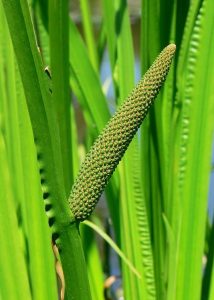Helophytes
Home " Helophytes
What are helophytes?
Helophytes is the collective name for plants that grow above water but have their roots in very wet soil. They can take root even in the water bed where there is no oxygen. Helophytes can transport oxygen to their roots themselves. This oxygen transport is the hallmark of helophytes.
This also explains why helophytes are often used in water purification, especially nutrient conversion. This is because the oxygen they transport to their roots also provides bacteria and other micro-organisms with oxygen. This allows them to maintain all kinds of breakdown processes in the soil and water. The advantage for the plant is that the substances released are immediately available as nutrients, allowing many helophytes to grow vigorously.

What plants are helophytes?
The best-known helophyte is reed. But there are also many helophytes with high ornamental value such as the yellow lis. Incidentally, these can also grow in the slightly less wet places (a so-called geophyte).
There are special marsh plants which one does not need to plant in the soil such as Crabber or that can be found both on the bank and floating on the water such as Marsh Forgetmenite.
In addition, there are marsh plants that either take root in the riparian zone, just under water, or grow in the middle of a pond, such as arrowhead. There are also many plants that grow on the bank and form offshoots from there into the water such as water strawberry and water trefoil, which, by the way, can actually take root in the water bottom.
Making helophyte filter to combat algae growth?
As you can read, there are many possibilities with helophytes. If you want to keep the water in your pond clean and rich in oxygen, you can hardly ignore this group of plants. Helophytes also facilitate pond maintenance because you only have to mow and remove/compost the superfluous or dead vegetation from the bank once a year. In this way, you easily remove nitrate and phosphate, the main nutrients for algae, from the water system.
An interesting option is also the installation of a helophyte filter or plant filter, which is very helpful in keeping your pond free of algae. We can help you with this if you wish.
Tips on creating a helophyte filter
Everyone likes to see a clean and clear water system. As mentioned, helophytes can make a big contribution to this. However, many species can obscure the view of the water due to their size. Therefore, use low-growing helophytes in the foreground, such as common pennywort, water pennywort, marsh forgetmenite. Just in the water, low-growing plants such as coniferous water rushes, white watercress, peatroot and with some current also brookpunge.
When using pond liner and rubber, some helophytes are a no-go because of roots that can grow through the pond liner, leaking your pond! Be well advised, as sometimes the names are very similar. Reed canary grass, for example, but not reeds. Dwarf cattail can do, but small cattail cannot.
Helophytes pruning or mowing. Be on time.
High-rising helophytes such as bulrush, reed, calamus, big hedgehog head or big cattail and almost all species of lisces produce a lot of biomass. When this is cut and disposed of, a corresponding amount of nutrient has been withdrawn from the system. This can sometimes go so far that subsequent growth or flowering is disappointing. Additional fertilisation is possible, but avoid leaching into the water at all times, in connection with algae growth. Thinning out the vegetation, including the roots, is of course better and cheaper than fertilising. Late pruning or mowing, for instance in early spring, also helps. By then, most of the nutrients have already been transported from the foliage to the roots.
